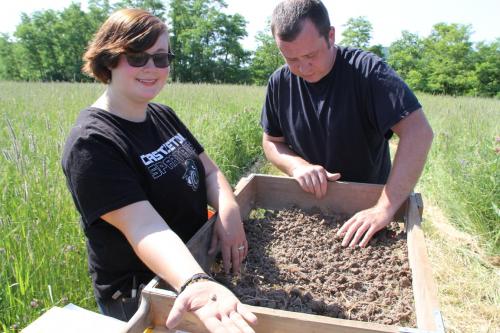Vermont Business Magazine Bringing to light remnants of the past, Castleton University has partnered with the Vermont Archaeological Society, the Natural Conservancy, and the Vermont Division for Historic Preservation for an archeological dig project currently underway at the Nature Conservancy’s Helen W. Buckner Preserve at Bald Mountain in West Haven, Vermont. Titled the South Champlain Historical Ecology Project (SCHEP), the endeavor is designed to examine long-term patterns in human-environment interactions within the southern Lake Champlain Basin.
 Castleton University photo
Castleton University photo
“We hope that the project can help provide a more comprehensive and inclusive history for this important part of Vermont,” said Castleton Part-Time Faculty Member of the Year and Project Director, Matt Moriarty.
SCHEP is a non-profit, academic endeavor, initiated in 2016 and is funded by grants from the Vermont Community Foundation’s South Lake Champlain Fund, Castleton University and the VAS.
During the summer 2016 field season the group has been excavating Phase I test pits to identify site boundaries of a Native American campsite, date its occupation, and identify potential activity areas. To date, the group has already recovered numerous chert flakes and several flake tools.
Participating members of the dig include Castleton professors Matt Moriarty and Paul Derby, along with several other local archeologists. The team also has a crew who work with them hand in hand, made up of Castleton students and local volunteers.
“SCHEP provides students the opportunity to participate in an ongoing research project,” explained Moriarty, adding that the hands-on experience helps promote the protection and preservation of cultural resources. “Along the way, they will learn many of the skills associated with archaeological fieldwork, as well as have the opportunity to help analyze artifacts from these investigations as independent studies.”
While archaeology constitutes a component of the project, SCHEP is intended to grow into a multidisciplinary collaboration among a wide range of specialists and interested parties. It is hoped that these collaborations will help generate a more comprehensive and inclusive history for the biologically diverse and naturally beautiful Vermont location.
Results of the dig will be rigorously recorded with appropriate agencies and organizations and studied for conservation and future protection of cultural resources.
“We are incorporating local volunteers and students in all phases of research and plan to conduct outreach events at local schools and organizations following each field season,” said Moriarty. “Going forward, we hope to partner with other local researchers and organizations as part of a multidisciplinary research effort.”
Source: Castleton University 7.28.2016

